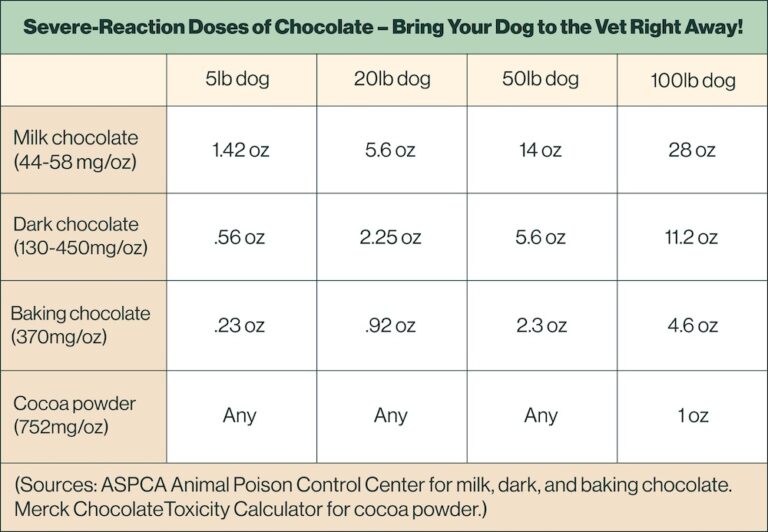Can dogs eat chocolate? The answer is a firm no.
Chocolate is one sweet treat to keep well away from your dog as it can result in significant illness, and, in rarer cases, death. Chocolate contains theobromine and caffeine—compounds belonging to the group methylxanthine alkaloids. Dogs have a much harder time metabolizing them and they stay in their system much longer than they do in ours. Theobromine is toxic to dogs and affects the central nervous system, heart, and respiratory system.
Key info about chocolate
You’ve probably heard that chocolate is bad for dogs, but what does that mean in practical terms? How much chocolate does it take to cause harm? It depends on the size and type of the chocolate, and the size of the dog.
The amount of toxic theobromine varies from one type of chocolate to another. Dark chocolate tends to be higher in theobromine than milk chocolate, and white chocolate contains even less (though keep in mind that a chocolate treat tends to contain loads of butter and sugar and is therefore never a good option for dogs).
Cocoa powder, gourmet dark chocolate and baking chocolate pose the highest risk with 130 to 450 mg of theobromine per ounce. Milk chocolate contains between 44 and 58 mg per ounce.
To put that in terms of everyday chocolate products you might have on hand:
- A name-brand, standard-sized (1.55 oz)., milk-chocolate bar has about 64 mg of theobromine.
- One ounce of baking chocolate can have around 350 mg, so a full 4-oz bar would be a whopping 1400 mg of theobromine.
Though chocolate ingestion is rarely fatal in dogs, even a moderate amount of chocolate can cause harm, especially in smaller dogs.
Toxic doses of theobromine have been reported as low as 20mg per kilogram of a dog’s body weight (1 kg is about 2.2 pounds). A dose this size may cause agitation, hyperactivity, and gastrointestinal symptoms.
Higher doses of theobromine (over 40 mg/kg) may cause cardiovascular symptoms such as racing heart rate, high blood pressure, or arrhythmia.
Doses of theobromine over 60 mg/kg may induce neurologic symptoms including seizures and tremors while doses over 200 mg/kg have been known to be fatal.
So, going back to our everyday chocolate items, a 45-pound dog could eat one ounce of baking chocolate and show very mild signs of poisoning; if you have a 5-pound dog, that one ounce of baking chocolate is enough to cause serious harm (you can find chocolate “calculators” like this one, to help you determine how toxic that sneaked treat may be).

The benefits/drawbacks of chocolate for dogs
There are no benefits to giving your dog chocolate, only drawbacks—and the drawbacks can be serious. Be sure to keep your chocolate treats stored away from counter-surfing snouts and paws.
If you suspect your dog has ingested a significant amount of dark chocolate, consult your vet as soon as possible—don’t wait to see what happens.
Signs of chocolate poisoning include vomiting, diarrhea, tremors, elevated heart rate, rapid breathing, and seizures.
In conclusion: Never feed your dog chocolate, even in small amounts!
If you think your dog has a taste for something sweet, you can’t go wrong with offering blueberries or strawberries as occasional treats that pack loads of health benefits.
Chart: When your dog is in danger
If a dog accidentally eats chocolate, when do they need emergency veterinary care? This chart provides estimates for a few example dogs—but different chocolate products have different proportions of cocoa, and dogs have individual levels of susceptibility to theobromine and caffeine.

Much smaller doses than those listed here can cause vomiting, diarrhea, hyperactivity, and agitation—the quantities listed above could cause serious cardiac problems, and call for immediate medical attention. Keep your dog away from chocolate. And, when in doubt, call your veterinarian right away!
Pet health is an important topic. That’s why The Farmer’s Dog editorial team carefully vets and reviews every piece of content we publish. We deliver evidence-based advice and medically reviewed facts that focus on pet nutrition, health, and well-being. The mission of this site is to help people provide the best care possible for their dogs by publishing only trustworthy, accurate, and timely health information.
This article was vetted by a vet.
Reviewed by Alex Schechter, DVM, founding veterinarian at Burrwood Veterinary. He was previously founding veterinarian at Pure Paws Veterinary Care.




